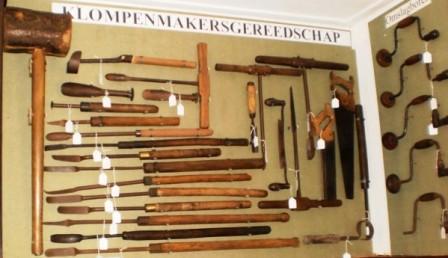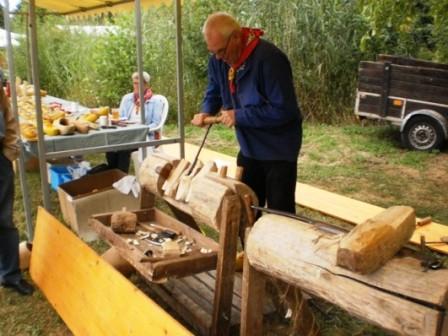A clog (or ‘hollow block’) is wooden footwear that was primarily worn by workers and peasants. ‘Trippe’ and ‘platijn’ have wooden soles with a leather foot strap. They are low cut clogs with a leather patch over the instep. That is easier and less painful for inexperienced clog wearers.
 Clogs are usually of poplar wood (or willow wood). The clog maker shapes the wood if it is not dried yet: it's not so hard, and more flexible. It also reduces the chance of rupture.
Clogs are usually of poplar wood (or willow wood). The clog maker shapes the wood if it is not dried yet: it's not so hard, and more flexible. It also reduces the chance of rupture.
Willow clogs are more durable (and warmer) than the clogs made of poplar wood.
A spoon drill is a sharp-edged spoon (with a top T handle) which is used for cutting / drilling the wood out of the (c)lump.
A clog is waterproof. You can put it as a boat on the water. Also wooden vats and barrels are watertight. Wood that remains wet course does take moisture. That can be decreased by varnishing or dyeing the outside. For the 'better' waterproof clog elm was used (in slaughterhouses, dairies and the fish industry).
To keep the feet better warm straw was in the winter tucked in the clogs.
Of right splitting pen wood or pin wood (alder buckthorn or dogwood (Rhamnus frangula)) wooden nails were cut to fasten soles on shoes or clogs.
In worn clogs sometimes all series of holes were pierced to knock in those pins or pegs, from more resistant buckthorn wood. Haughting (raising) clogs, it was called.
 The French word for clog is sabot. Workers who were laid off because the employer replaced them by a machine, threw a clog in the machine so that the machine crashed. Hence the words saboteur and sabotage. Clog up...
The French word for clog is sabot. Workers who were laid off because the employer replaced them by a machine, threw a clog in the machine so that the machine crashed. Hence the words saboteur and sabotage. Clog up...
Nowadays there are clogs in soft plastic as Crocs.
In the 17th century, Tsar Peter the Great saw the Dutch army used footwraps. A rectangular cloth was folded around the foot, and wound up around the leg. He introduced the use to his army, where the 'portyanki' remained commonplace until 2013.
Cutting a clog is basically simple: just cut and remove everything that is not clog!
Better a hole in your clog, then the other way around.
